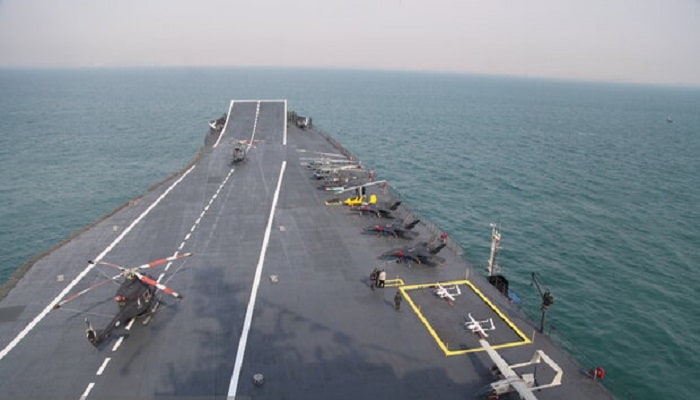PNN – In a report, Al Jazeera examined part of Iran’s military power and the deadly weapons it is capable of using in its attacks to respond to the Israeli regime’s aggression.
According to the report of Pakistan News Network, citing Al Jazeera, At dawn on April 14, 2024, air raid sirens sounded in Tel Aviv and throughout occupied Palestine, and surveillance cameras distributed throughout the occupied territories showed a swarm of drones and missiles fired directly from Iran, following a specified and announced route towards occupied Palestine.
At that time, the Islamic Republic of Iran carried out this operation in response to the Israeli regime’s attack on its consulate in Damascus, the capital of Syria, before the fall of Bashar al-Assad’s government, within the framework of an announced change in the rules of engagement of the Israeli regime, exposing the world to the anticipation of the nature of Iran’s subsequent responses.
Although Iran’s nuclear project has always been a significant development in the military industry, Iranian achievements in other fields, especially considering the country’s drone weapons and missile program, deserve more attention.
Read more:
Iran’s drone power
Iran has a large number of long-range drones that can reach the border of occupied Palestine and even beyond. The most famous of these drones is the “Futros” drone, which operates in the field of reconnaissance, surveillance and offensive operations. This drone was unveiled in November 2013 and has an operational range of between 1,700 and 2,000 kilometers.
The “Mohajir 10” drone, unveiled in 2023, is another prominent Iranian drone with an operational range of 2,000 kilometers. Assessments indicate that this drone may be used, along with a number of others, in Iran’s expected response to the occupying regime.
Al Jazeera adds that, however, there is not much information about Iranian drones and how they are used in attacks on the Zionist regime. However, the “Shahed 136” drone is one of Iran’s milestones in the drone industry. By the end of 2022, the Islamic Republic of Iran had developed various types of armed drones with different ranges, powers, and uses, and these drones are very effective.
One of the features of the Shahed 136 drone is its relatively low cost, with estimates indicating that the cost of each Shahed drone is typically up to $50,000. The Shahed 136 is considered a suicide drone and is launched from a ground base and continues to fly until it reaches a certain distance from the target.
This drone can patrol over a target area for hours and, after finding a target, launches itself like a missile. The main mission of this drone is to attack fixed ground targets whose coordinates are usually known, but it is ineffective against moving targets.
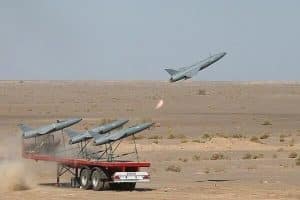
A brief history of Iran’s drone project
The secret to the development of Iran’s drone industry dates back to the 1980s, when a series of international sanctions were imposed on Iran, severely affecting its military. Therefore, the Islamic Republic of Iran began to think about using cheap alternatives that could be produced domestically.
The Iranian military has developed its naval capability by building a large number of small boats armed with cannons and precision-guided missiles to provide a deterrent against the large surface vessels of the US Navy. This is the same strategy that Russia is now pursuing with its navy, especially given its ability to develop precision missiles, including hypersonic missiles, which Iran is also developing.
In this regard, Iran began investing in combat drones, and in 1985, the “Mohajir 1” drone was launched on the market after engineering research program initiated by Iranian universities. The drone had a narrow cylindrical body, two rear booms, and straight wings mounted on the rear of the drone, and carried a fixed camera.
During the First Gulf War, the Muhajir 1 drone was primarily used for photography to correct artillery systems and air strikes, and could also cause jamming. The following year, the Ababil 1 drone was tested and used to monitor Iraqi movements and positions.
Most importantly, many of the components used in making drones are not military components and can be found in electronics ranging from toys to smartphones, making them easy to manufacture.
In 1990, the Ababil drone underwent a redesign, and its prototype is currently being produced by the Iranian Aircraft Industries Company, which is affiliated with the Islamic Revolutionary Guard Corps. The Ababil drone initially operated within the visual range of its ground station, which usually reached a few dozen kilometers, and today the Ababil 5, unveiled in April 2022, has a range of 480 kilometers.
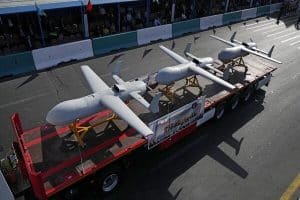
For years, Iranians have realized the significant advantages of drones, and given Iran’s mountainous geography and the difficulty of moving security and military forces in some border areas such as Balochistan, which stretches between Iran, Pakistan, and Afghanistan, drones are of great importance in the areas of surveillance and reconnaissance within the country.
Iranian drones usually fly in groups during operations to minimize the possibility of error when facing advanced defense formations. Certainly, Iran’s drone industry is progressing day by day, and what is important to the Iranians in this regard is that the drone industry is currently helping them in their grand plan, which is to build a military system capable of conducting asymmetric warfare against an enemy with advanced military capabilities.
The Islamic Republic of Iran’s Strategy in Asymmetric Warfare
The use of drones in asymmetric warfare, in addition to being inexpensive, has other features. Drones are very flexible and dynamic weapons and can adapt to a wide range of scenarios and objectives, perform surveillance missions, and collect information about enemy movements, forces, infrastructure, and targets in a short time. Drones can also carry missiles or bombs and attack strategic enemy targets, as well as being capable of highly precise airstrikes.
This is especially important when drones operate in tactical groups and can overwhelm enemy defenses. For example, in a combat scenario, the primary role of drones like the Migrant 6 would be to disrupt enemy air defenses and pave the way for penetration.
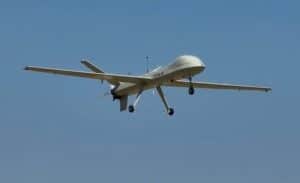
Peter Zimmerman, a professor of nuclear physics at the Institute for Strategic and International Studies in Washington, argued in a research paper published in 1994 that countries like Iran do not need a gold medal in military technology to be effective and ready for confrontation, but that a bronze medal is more than enough for them.
Zimmerman’s point here is that sometimes asymmetric military tactics can best respond to a weaker side against a stronger side, especially when there is a significant divergence in strategic interests.
Combined Operations Tactics
Combined arms warfare is a combat tactic that integrates the various combat arms of an army to achieve complementary effects, with the effective weapons of an army attacking the enemy simultaneously. As a result, the actions the enemy must take to defend itself against a combined attack make it more vulnerable to subsequent attacks.
This was evident in Iran’s “True Promise 2” attack on the Israeli regime, which could also be a test of the effectiveness of this type of combined attack. Assessments show that Iran used drones, cruise missiles, and ballistic missiles simultaneously in its latest attack on the Israeli regime.
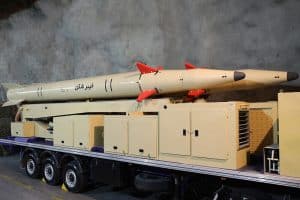
Several analysts suggest that Iran has probed the locations and methods of the Israeli defenses through this attack, especially since it did not reportedly use new, undeclared weapons in the attack. This means that Tehran has new weapons and offensive methods in mind for future attacks on the Israeli regime.
Forward defense
Of course, if the Iranians want to take the initiative in this war, they must develop their capabilities in all areas to a more precise level.
Iranian Defense Ministry sources announced at the end of 2023 that Iran and Russia had reached an agreement on final arrangements for concluding a contract for Russian-made Su-35 fighter jets and helicopters. Until then, the Iranian Air Force had only a few old attack aircraft, and assessments suggest that Iranian drones will operate in a unique and compatible manner alongside Sukhoi fighters, increasing their military capabilities in the region.
Iran pursues an approach called forward defense, through which it seeks to keep confrontation away from its territory. The Islamic Republic of Iran has created an axis in the region centered on rejecting American and Israeli hegemony, which has allowed Tehran to have a visible and influential presence in countries such as Yemen, Lebanon, and Syria.
In this context, Iran’s increasingly technologically advanced drones and missiles are playing their role well, and the country is exporting drone and missile technology to its allies, strengthening its relationship with them and increasing their capabilities to confront the common enemy.
At first, Westerners thought that drones were simply a cheap alternative to Iran’s air fleet, but it later became clear that the country had put drones on the front lines of war with a completely different strategy than what the world knows, and that these drones were not actually the main weapons.

